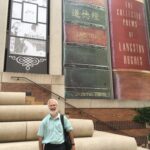 We were invited to attend the p2pu.org workshop in Kansas City since we had used their model for peer-to-peer training and written up our results in a white paper. The following is PBDD’s impression of the workshop and what we learned. The organizers gathered a lot of information from the workshop and are using that in planning. They have shared this with workshop participants and will undoubtedly have more information on their website. Here’s the information they provided prior to the workshop: https://kc2018.p2pu.org/
We were invited to attend the p2pu.org workshop in Kansas City since we had used their model for peer-to-peer training and written up our results in a white paper. The following is PBDD’s impression of the workshop and what we learned. The organizers gathered a lot of information from the workshop and are using that in planning. They have shared this with workshop participants and will undoubtedly have more information on their website. Here’s the information they provided prior to the workshop: https://kc2018.p2pu.org/
Since we think learning circles, or peer-to-peer learning, are a very useful way to increase the completion rate of online training, and we are thinking of having a PBDD workshop at the next NDIA conference, we found this very well-run workshop useful. Barry and I have experience with conferences and workshops in the corporate world, but not as much in the nonprofit world. Some of the things that made this a good workshop included:
- Having the majority of participants’ time being spent on specific tasks within small groups with clear outputs expected.
- While P2PU had clearly planned for this workshop carefully, they were relaxed during it and prepared to change direction if needed, such as adding another exercise when we were ahead of schedule.
- Goal setting on a P2P community basis, as well as on a workshop basis, as well as on the basis of attending organizations, are all great ways to ensure that participants have a satisfactory experience and leave being clear about their next steps.
- P2PU did a good job of demonstrating that there’s no need to explain in detail if an activity is modeled properly and some of the participants already have experience with the activity. An example of this was the plus/delta activity at the end of the first day. There was no explanation given. A P2PU person just started doing it, and while a couple of people looked confused, everyone understood what to do by the time it was their turn.
- Even in this digital age, writing things on notecards or on worksheets increases participation so all activities had pens, paper and worksheets.
- Logistics matter such as food, drinks, space. The Kansas City Library was a great location, the food and drink were fabulous.
- Building breaks into the schedule keeps people enthused. As one of the P2PU people said, “If you wait until people need a break, it’s too late.”
- It’s good to make all participants feel valued. For example, the questions about sharing experiences with peer-to-peer learning included a question about future plans for people who hadn’t run a learning circle yet.
Part of what convinced us to make a 7.5 hour drive to Kansas City was the published agenda complete with goals for the workshop. These goals included getting to know one another, documenting stories, outcomes and best practices for supporting learning circles. It was clear that it would be a workshop, not a lecture series. P2PU shared their prep material. Thanks to the Kansas City Public Library for a great location and handling logistics. The event was supported by an IMLS grant with additional support provided by the Siegel Family Endowment, which allowed for additional partners to attend.
 The get-together started with a reception on Wednesday evening. Many people exclaimed, “It’s so nice to finally meet you.” The food was from Jack Stack Barbecue and included many great side dishes. Since most peer-to-peer classes happen at libraries, the vast majority of the attendees were from libraries all over North America. A common topic of conversation was where were you from, followed quickly by discussing peer-to-peer training. It was clear that the topic generated a lot of enthusiasm.
The get-together started with a reception on Wednesday evening. Many people exclaimed, “It’s so nice to finally meet you.” The food was from Jack Stack Barbecue and included many great side dishes. Since most peer-to-peer classes happen at libraries, the vast majority of the attendees were from libraries all over North America. A common topic of conversation was where were you from, followed quickly by discussing peer-to-peer training. It was clear that the topic generated a lot of enthusiasm.
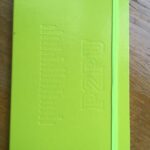 On Thursday morning, after getting name tags and a cool notebook with the names of the cities everyone was from, we had the opportunity to list our goals for the meeting. We formed a circle and introduced ourselves by stating a fun fact about our home town. One of the enjoyable aspects of this workshop was how much thought the P2PU team (Sharon, Nico, Grif, Dirk) put into planning the activities to help people connect with one another. This was enhanced by working with a group of people at a table. In fact, most of our time was spent working in small groups, not sitting back and listening. The workshop followed one of the core principles of learning circles: we are all learners and we are all teachers.
On Thursday morning, after getting name tags and a cool notebook with the names of the cities everyone was from, we had the opportunity to list our goals for the meeting. We formed a circle and introduced ourselves by stating a fun fact about our home town. One of the enjoyable aspects of this workshop was how much thought the P2PU team (Sharon, Nico, Grif, Dirk) put into planning the activities to help people connect with one another. This was enhanced by working with a group of people at a table. In fact, most of our time was spent working in small groups, not sitting back and listening. The workshop followed one of the core principles of learning circles: we are all learners and we are all teachers.

Some of the information shared about learning circles by the P2PU team was that as of May, 2018;, 385 learning circles had taken place. These are typically 4-8 weeks sessions, although one 26-week learning class just kept going. Learning circles have happened in over 100 cities. This is not possible with just the four people from P2PU, it requires the help of people like the attendees at the workshop. The following pictures show the P2PU team (Sharon, Nico, Grif, Dirk) in action at the workshop.
P2PU shared a little history about learning circles. In 1900, Study Circles in Sweden started with the labour movement. Here’s a blog about the Swedish method of adult information.
In 2014, P2PU changed their focus from on-line only to pairing with the Chicago Public Library to run in-person study groups, known as learning circles. Learning circles, getting together as a group without a teacher, has been happening for thousands of years. Now, it’s often connected with an e-course.
After a break, participants lined up by location–based on distance and direction from Kansas City in the middle. This was a nice visual representation of who were neighbors geographically, as well as who was at the workshop. Then we lined up by the number of learning circles we have facilitated. Someone had done seven. We split into groups, ensuring that each table had someone who had led a number of learning circles, as well as a P2PU team member or board member to take notes. We read through a series of scenarios, deciding which ones were learning circles. We documented the values, methods and commonalities of learning circles.
The ones for my table were:
- Free
- Participant/peer learning
- Responsive to needs/unexpected roadblocks
- Goal oriented → individual & group
- Equality – no lecturers in control – no formality in advance
- Community experts are participants
- Self selected/self interest plus group dynamic (individual, group)
- Tools to build community & self-respect
- Lifelong learning, try something new
- Soft skills acquisition
By working out the definition of a learning circle this way, we all felt ownership in the joint definition. A learning circle is a free, peer-led lightly facilitated small group of learners coming together to achieve group and personal educational goals.
In groups, we shared our experiences with learning circles and adult education. For those who haven’t run any learning circles yet, they were asked to share their general 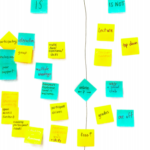 plans. Each group identified common themes and placed them on sticky notes, using green paper to share what was working, lessons learned, best strategies. We used red notes for things that weren’t working. (And there was a ‘parking lot’ for any other issues.)
plans. Each group identified common themes and placed them on sticky notes, using green paper to share what was working, lessons learned, best strategies. We used red notes for things that weren’t working. (And there was a ‘parking lot’ for any other issues.)
After lunch, we learned more about P2PU’s role, then about the set up for the next discussion. There were seven tables with specific topics to be discussed at each table for fifteen minutes, then everyone moved to another table of interest. We did this for one hour, so each participant could choose four topics of interest. Each table was to document what was working, what challenges they faced, and examples or resources to share. We used different colored note paper for each area. Some of the ideas that came up at tables I attended were:
- Beanstack.com – online badging resource – scavenger hunt provider.
- Have a way for Learning Circle groups to select to have a check-in message one month, two or even three months later to see how people are doing compared to their goals. It could be something where they share with the group, so the group attention helps people succeed.
- Could also have a reunion a month after the last class.
After a break, we each chose the table that we wanted (similar to before) with the aim to create resources and support. There was a resource creation document to help us choose a challenge from the red cards, list the inspiration we found in the green/blue cards and document the resource we were developing. I was disappointed that my table on measuring impact didn’t pay much attention to the cards. We discounted most of the red (issue) cards and didn’t take advice from the green or blue cards. People talked about ‘the model’ for most of the time. We did have a useful discussion about how to lead people into answering questions in a consistent manner, but didn’t record much. One of the tables came up with a tip sheet that really used the cards from the table which seemed like a better use of the time.
We ended the day with the plus/delta activity in a large circle where each person mentioned what they liked, or what they learned and then what they would like to change. Then we had to hurry as the library closed at five. Some people met at a bar later in the evening.
On Friday, after a little set up, we did a “speed dating” session with six rounds of one-on-one pairing where people talked for two minutes about what they’re passionate about–related to their work, learning circles, or whatever they wanted to talk about. While it was difficult to hear, it was an opportunity to either get to know people better, or to chat with people we hadn’t talked with much.
P2PU discussed their mission, funding and sustainability issues. Then we got into small groups of people who were from the same organization and worked on our goals, and how P2PU can support these, or people in the room could support them. Once again, this discussion was aided by a thoughtfully prepared worksheet that covered people’s visions for learning circles in their community, goals to achieve that vision, activities over the next few months, and how P2PU might help with any gaps that people can identify.
There was an opportunity for questions, addressing the parking lot issues, and anything else that people wanted to discuss. P2PU shared new things they were doing. One of which is that near the end of a learning circle, the group writes an email to a future learning circle, talking about what they learned, or liked. New learning circle participants get that email individually before they start the class. It seemed a neat way to build a connection.
A couple of statements that resonated with me during the workshop:
- “Vision: Learning circles to be as common as book clubs.” — Kate from Chicago library
- “Goal is to mutually support relationships.” — not sure who said this
- “Want libraries and other spaces to be open and accessible to all.” Nico from P2PU
If you want to learn more about learning circles, please ask us for more information or check out their website at https://www.p2pu.org/. You might even find a class in your area that you can join! It’s a great way to get started.
Katherine Lato, VP-Communication PBDD

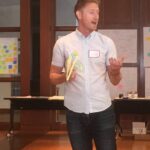

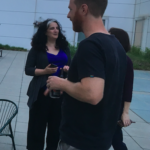
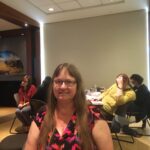
By Peer to Peer University July 24, 2018 - 9:30 am
[…] Read a detailed summary of our Gathering from Partners Bridging the Digital Divide. […]
By P2PU - Peer 2 Peer University - Partners Bridging the Digital Divide September 5, 2018 - 12:51 pm
[…] mentioned in our June 2018 Newsletter, PBDD attended the P2PU workshop in Kansas City and met other learning circle participants as well […]